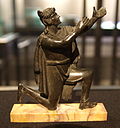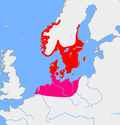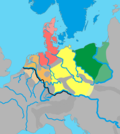Romano-Germanic describes the conflation of Roman culture with that of various Germanic peoples in areas successively ruled by the Roman Empire and Germanic... 5 KB (454 words) - 06:54, 6 March 2024 |
bounded the ancient Roman provinces of Germania Inferior, Germania Superior and Raetia, dividing the Roman Empire and the unsubdued Germanic tribes from the... 18 KB (1,984 words) - 16:59, 15 February 2024 |
the context of those Germanic rulers who after 476 AD and during the 6th century ruled territories formerly part of the Western Roman Empire, especially... 9 KB (1,269 words) - 09:42, 31 March 2024 |
Archaeology of Northern Europe (redirect from Germanic Iron Age) Age into "Pre-Roman Iron Age", "Roman Iron Age" and "Germanic Iron Age" is due to Swedish archaeologist Oscar Montelius. The Pre-Roman Iron Age (5th/4th–1st... 23 KB (2,425 words) - 17:48, 8 May 2024 |
 | Germania (category Germany in the Roman era) or Germanic Barbaricum to distinguish it from the Roman province of the same name, was a historical region in north-central Europe during the Roman era... 28 KB (2,981 words) - 14:30, 10 May 2024 |
 | The West Germanic languages constitute the largest of the three branches of the Germanic family of languages (the others being the North Germanic and the... 57 KB (4,755 words) - 05:45, 13 May 2024 |
Germanic society. Mentions of Germanic seeresses occur as early as the Roman era, when, for example, they at times led armed resistance against Roman... 85 KB (11,068 words) - 18:24, 29 April 2024 |
 | Teutons (redirect from Teutons (Germanic tribe)) Caesar described them as a Germanic people, a term he applied to all northern peoples located east of the Rhine. Later Roman authors followed his identification... 15 KB (1,840 words) - 19:08, 4 May 2024 |
 | to have been a constant in Germanic society, and archaeology indicates this was the case prior to the arrival of the Romans in the 1st century BCE. Wars... 30 KB (3,521 words) - 11:27, 16 April 2024 |
 | North Germanic peoples, Nordic peoples and in a medieval context Norsemen, were a Germanic linguistic group originating from the Scandinavian Peninsula... 91 KB (10,684 words) - 21:22, 29 April 2024 |
 | the Germanic tribes, the earliest evidence of Germanic culture dates to the Jastorf culture in Northern Germany and Denmark. Contact with Germanic tribes... 62 KB (6,112 words) - 15:16, 3 May 2024 |
 | The North Germanic languages make up one of the three branches of the Germanic languages—a sub-family of the Indo-European languages—along with the West... 57 KB (5,429 words) - 10:22, 25 March 2024 |
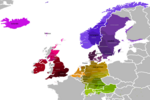 | The Germanic languages are a branch of the Indo-European language family spoken natively by a population of about 515 million people mainly in Europe,... 92 KB (9,397 words) - 22:20, 10 May 2024 |
 | Indo-European languages (redirect from Indo-Germanic) Gupta period; attestation of Armenian. Proto-Slavic. The Roman Empire and then the Germanic migrations marginalize the Celtic languages to the British... 111 KB (10,129 words) - 20:55, 12 May 2024 |
Language Contact and the Origins of the Germanic Languages is a 2014 scholarly book by the Dutch linguist Peter Schrijver, published by Routledge. Chapter... 9 KB (1,107 words) - 07:05, 28 March 2023 |
 | Goths (redirect from Germanic Goths) romanized: Gutþiuda; Latin: Gothi, Greek: Γότθοι, translit. Gótthoi) were Germanic people who played a major role in the fall of the Western Roman Empire... 173 KB (18,811 words) - 22:38, 5 May 2024 |
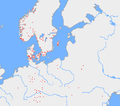 | Elder Futhark (redirect from Common Germanic Futhark) associated with East Germanic peoples. The latter group disappeared during the 5th century at the time of contact of the Goths with the Roman Empire and their... 33 KB (3,742 words) - 19:22, 1 May 2024 |
the pre-Roman Iron Age in Northern Europe (500 BC – 1 AD) as having implications in regard to the stability and later development of the Germanic language... 11 KB (1,247 words) - 19:35, 5 March 2024 |
Interpretatio germanica (category Germanic mythology) closer contact. Some evidence for interpretatio germanica exists in the Germanic translations of the Roman names for the days of the week from Roman deities... 4 KB (419 words) - 15:04, 9 May 2024 |
Tacitus, the Roman historian most agree that the culture’s roots were present from about 1–400 AD onward. The ancestors of the medieval Germanic peoples are... 8 KB (1,059 words) - 21:22, 3 April 2024 |


